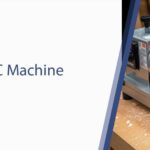Types Of CNC Control Systems:
In the intricate world of precision manufacturing, the CNC (Computer Numerical Control) control system stands as the undisputed brain of the operation.
It is the invisible force that translates digital designs into tangible, perfectly machined parts. For industries ranging from aerospace and automotive to woodworking and custom fabrication, understanding the nuances of these control systems is not just beneficial—it’s fundamental to achieving efficiency, precision, and a competitive edge.
This comprehensive guide, brought to you by the experts at Radonix, will delve deep into the various types of CNC control systems.
We’ll explore their classifications, underlying technologies, and practical applications. Whether you are a seasoned engineer, a machine operator, or a business owner looking to invest in CNC technology, this article will equip you with the knowledge to navigate the complexities of CNC control and make informed decisions.
As a company with over 17 years of experience in designing and manufacturing high-performance CNC controllers, we at Radonix are passionate about empowering the industry through innovation and knowledge.
The Foundational Classification: Open-Loop vs. Closed-Loop Systems
At the most fundamental level, CNC control systems are categorized based on their feedback mechanism, or lack thereof. This distinction gives rise to two primary types: open-loop and closed-loop systems.
Open-Loop Control Systems: Simplicity and Cost-Effectiveness
An open-loop CNC control system operates on a one-way communication street.
The controller sends commands to the motor, but it does not receive any feedback to verify if the motor has reached the desired position. These systems are typically built with stepper motors, which move in discrete steps.
The controller calculates the number of steps required to reach a specific coordinate and sends the corresponding electrical pulses to the motor.
Advantages of Open-Loop Systems:
- Cost-Effective: The absence of feedback devices like encoders and the simpler drive systems make open-loop controllers more affordable.
- Simplicity: Their design and operation are straightforward, making them easier to implement and maintain.
- High-Speed Operation: With no feedback data to process, these systems can often achieve high speeds for rapid positioning.
Disadvantages of Open-Loop Systems:
- Lack of Accuracy: Without feedback, there is no way to correct for errors such as motor stalls, missed steps, or mechanical inaccuracies. This can lead to dimensional deviations in the final product.
- Susceptibility to External Factors: Variables like tool wear, variations in material hardness, or friction can affect the machine’s performance without the controller’s knowledge.
- Limited Applicability: Due to the potential for inaccuracies, open-loop systems are generally suited for less demanding applications like basic routing, engraving, or drilling where absolute precision is not the primary concern.
Closed-Loop Control Systems: The Pursuit of Unwavering Precision
In stark contrast, a closed-loop CNC control system incorporates a feedback loop, creating a continuous two-way communication channel between the controller and the motors.
These systems utilize servo motors equipped with encoders or resolvers that constantly report the motor’s actual position and velocity back to the controller.
The controller compares this feedback with the programmed commands. If any discrepancy or error is detected, the controller instantly adjusts the signal to the motor to correct its position, ensuring that the machine tool follows the intended path with exceptional accuracy.
Advantages of Closed-Loop Systems:
- Superior Accuracy and Precision: The ability to self-correct for errors ensures that the machine maintains high precision even under varying loads and conditions. This is critical for complex and high-tolerance parts.
- Enhanced Reliability: Closed-loop systems can compensate for mechanical wear and thermal expansion, leading to more consistent and reliable machining outcomes over the long term.
- Greater Power and Performance: Servo motors used in closed-loop systems offer higher torque and speed capabilities compared to stepper motors, enabling more aggressive and faster machining.
Disadvantages of Closed-Loop Systems:
- Higher Cost: The inclusion of servo motors, encoders, and more complex drive electronics makes closed-loop systems more expensive.
- Increased Complexity: The setup, tuning, and maintenance of a closed-loop system require a higher level of technical expertise.
Radonix’s Commitment to Precision: At Radonix, we understand that for the majority of industrial applications, precision is non-negotiable. That’s why our range of CNC controllers, including the PC Smart and PC-Pro LAN series, are engineered to support both stepper and servo motors, allowing for the implementation of robust closed-loop systems. Our controllers are designed for demanding industrial environments where precision and operational reliability are paramount.
The Path to Perfection: Point-to-Point vs. Continuous Path Control
Another crucial classification of CNC control systems is based on how they control the movement of the tool from one point to another.
This leads to two main types: Point-to-Point (PTP) and Continuous Path control.
Point-to-Point (PTP) Control Systems
A Point-to-Point (PTP) control system is primarily concerned with the accurate positioning of the tool at a specific set of coordinates.
The path taken by the tool to get from one point to the next is not controlled.
The machine will move at its rapid traverse rate along a straight line to the next programmed location, where it will then perform an operation such as drilling, punching, or spot welding.
PTP systems are simpler in terms of their computational requirements and are well-suited for applications where the machining process occurs only at fixed points.
Continuous Path Control Systems
Continuous Path control systems, also known as contouring systems, are far more advanced.
They are capable of controlling the movement of the tool along a precisely defined path, which can be a straight line, an arc, or a complex curve.
This is achieved through a process called interpolation, where the controller calculates and coordinates the simultaneous movement of multiple axes to generate the desired contour.
Continuous Path systems are the backbone of modern machining and are essential for operations like milling, turning, and plasma cutting, where the tool is engaged with the workpiece throughout the cutting process.
There are several sub-categories of continuous path control, defined by the number of axes they can simultaneously control:
- 2D Control: This is the simplest form, controlling two axes (typically X and Y) simultaneously to create flat, two-dimensional profiles. Laser cutters and simple routers often use 2D control.
- 2.5D Control: This is an intermediate level of control. While it can move two axes in a coordinated manner (like in 2D), it can also move a third axis (usually the Z-axis) independently. This allows for creating pockets and features at different depths, but not for creating true 3D contoured surfaces.
- 3D Control: This is where true three-dimensional machining becomes possible. 3D control systems can interpolate all three linear axes (X, Y, and Z) simultaneously, allowing for the creation of complex, free-form surfaces and shapes. This is the standard for most modern CNC milling machines and machining centers.
- 4-Axis and 5-Axis Control: These advanced systems add one or two rotary axes to the three linear axes. A 4-axis machine typically adds a rotary table (A-axis), allowing for machining on four sides of a workpiece in a single setup. A 5-axis machine adds another rotary axis (B or C-axis), enabling the tool to approach the workpiece from a multitude of angles. This is crucial for machining highly complex parts like turbine blades, impellers, and medical implants.
Radonix: Powering Multi-Axis Machining: Radonix is at the forefront of providing powerful and versatile control solutions for multi-axis machining. Our product lineup includes 3-axis, 4-axis, and even 6-axis CNC controllers, such as the PC Pro LAN 6A. These controllers are designed with high-performance processors and advanced motion control algorithms to handle the complex calculations required for smooth and precise multi-axis interpolation. With features like high pulse rates (up to 500,000 pulses per second per axis) and large hardware buffers, Radonix controllers ensure that your machine can execute complex toolpaths without hesitation.
The Language of Control: G-Code vs. Conversational Systems
The way an operator interacts with a CNC machine is also a defining characteristic of its control system.
- G-Code Based Systems: For decades, G-code has been the standard programming language for CNC machines. It is a text-based language where commands (G-codes for preparatory functions and M-codes for miscellaneous functions) and coordinates are used to define the toolpath and machine operations. While powerful and versatile, G-code programming can have a steep learning curve.
- Conversational Systems: To make CNC programming more accessible, conversational control systems were developed. These systems feature a user-friendly graphical interface that guides the operator through the programming process using prompts, menus, and on-screen graphics. The operator inputs the desired part geometry and machining parameters, and the control system automatically generates the G-code in the background. This significantly lowers the barrier to entry for CNC operation.
The Evolution of CNC Control Systems
The world of CNC control is not static. It is constantly evolving, driven by advancements in computing power, software engineering, and a growing demand for smarter and more connected manufacturing solutions.
The Rise of PC-Based and Embedded Controllers
Traditionally, CNC controllers were proprietary hardware-based systems. However, there has been a significant shift towards PC-based controllers.
These systems leverage the power and flexibility of modern personal computers, often running on familiar operating systems like Windows.
This makes them more user-friendly, easier to integrate with other software and networks, and more readily upgradable.
Embedded controllers, on the other hand, are dedicated systems designed for specific applications, offering a compact and robust solution. Radonix offers a range of both PC-based and embedded controllers, providing flexibility to suit different machine designs and application requirements.
The Dawn of AI, IoT, and Cloud-Integrated CNC Control
The next frontier in CNC control is the integration of Artificial Intelligence (AI), the Internet of Things (IoT), and cloud computing. This is where Radonix is truly pushing the boundaries of innovation.
- AI and Machine Learning: AI algorithms can be used to optimize toolpaths for faster cycle times and improved surface finish, predict maintenance needs to reduce downtime, and adapt machining parameters in real-time to compensate for changing conditions.
- IoT and Cloud Integration: By connecting CNC machines to the internet and the cloud, manufacturers can unlock a wealth of new capabilities. This includes:
- Remote Monitoring: Keep track of machine status and performance from anywhere in the world.
- Real-Time Data Analytics: Collect and analyze production data to identify trends, improve efficiency, and make data-driven decisions.
- Predictive Maintenance: Use sensor data to predict when a component is likely to fail, allowing for proactive maintenance and avoiding costly unplanned downtime.
- Centralized Program Management: Store and manage CNC programs in the cloud, ensuring that the latest versions are always available to all machines.
Radonix’s Visionary Approach: We are proud to announce our new game-changing CNC controller, set to launch in Q3 2025. This next-generation controller embodies the future of CNC technology with:
- Cloud-Based Integration: Seamless remote monitoring and real-time data analytics for unparalleled control and efficiency.
- Open-Source Architecture: Full customization capabilities, allowing developers to tailor the controller’s functionalities to their specific needs.
- Unmatched Precision and Reliability: Built on our 17 years of industry expertise and commitment to quality.
This revolutionary product is a testament to our mission to provide smart, affordable, and customizable CNC controllers that empower manufacturers to thrive in the era of Industry 4.0.
Conclusion: Your Partner in Precision Control
The landscape of CNC control systems is diverse and dynamic.
From the foundational choice between open-loop and closed-loop systems to the advanced capabilities of multi-axis and cloud-integrated controllers, the options are vast.
Understanding these different types of systems is the first step towards optimizing your manufacturing processes and achieving your production goals.
At Radonix, we are more than just a provider of CNC controllers; we are your partners in innovation.
With our deep expertise, comprehensive product range, and forward-thinking approach, we are here to help you navigate the complexities of CNC control and unlock the full potential of your machines.
Explore our solutions and discover how Radonix can be the driving force behind your success in the world of precision manufacturing.
Contact Us:
- E-Mail: info@radonix.com
- Phone: +90 (553) 920 5500








